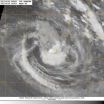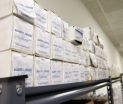(Press-News.org) Cyclone Giovanna made landfall in eastern Madagascar very early on February 14 and continues tracking in a southwestern direction toward the Mozambique Channel. NASA's Aqua satellite captured an image when Giovanna's center was close to the capital city of Antananarivo, and NASA's TRMM satellite saw powerful towering thunderstorms around its center before it made landfall.
According to BBC News, Giovanna made landfall near the eastern port city of Toamasina with winds gusting to 120 mph (194km). Giovanna brought heavy rain, and its strong winds flattened trees. Storm surges continue to pound coastal areas as Giovanna tracks over the fourth-largest island in the world. Rainfall totals are expected between 10 and 20 inches (250 to 500 mm), and may trigger landslides in higher elevations.
On February 14, 2012 at 07:15 UTC (10:15 a.m. local time - Madagascar/3:15 a.m. EST), the Moderate Resolution Imaging Spectroradiometer (MODIS) instrument on NASA's Terra Satellite captured a visible image of Cyclone Giovanna almost directly in the center of the island of Madagascar. Giovanna had weakened as a result of its interaction with land, and its eye had "closed."
Five hours later on Feb. 14, around 1200 UTC (7 a.m. EST), Giovanna was still tracking over land and weakened significantly to a minimal tropical storm. Maximum sustained winds were near 35 knots (40.2 mph/65 kph) and it was located about 100 nautical miles west of Antananarivo, Madagascar, near 19.6 South and 44.7 East. Giovanna is moving west at 14 knots (16.1 mph/26 kph).
The capitol city of Antananarivo reported a maximum wind speed of 32 knots (10-minute average) (~37 mph/~59 kph) with higher gusts.
As Giovanna approached Madagascar on February 13, another NASA satellite called the Tropical Rainfall Measuring Mission satellite (TRMM) had a fairly good early morning view if it. At 0333 UTC on Feb. 13, rainfall rates were obtained from TRMM Microwave Imager (TMI) and were overlaid on a visible/infrared image from TRMM's Visible and InfraRed Scanner (VIRS) instrument at NASA's Goddard Space Flight Center in Greenbelt, Md. At that time, Giovanna was an intensifying category 4 tropical cyclone with wind speeds estimated at over 125 knots (~144 mph).
Tropical cyclone Giovanna was located in the Indian Ocean east-northeast of Madagascar when it was classified as a tropical storm on February 9, 2012. When the TRMM satellite flew over Giovanna on February 11 at 1200 UTC, it was rapidly becoming more powerful. On the 11th, Giovanna had intensified to a category 3 tropical cyclone on the Saffir-Simpson scale with wind speeds estimated at 100 knots (~115 mph). That TRMM pass showed that an eyewall replacement was occurring at that time. A small ring of strong convective storms was located around the center of the center eye and other powerful storms were seen in the replacement eye further out from Giovanna's center.
The data from the TRMM Precipitation Radar (PR) data were also used to create a 3-D image of the storm. This image, looking from east, shows the structure of Giovanna's double eye wall. TRMM PR data shows that the tallest storm towers reaching to heights of almost 15km (~9.3 miles) were on Giovanna's eastern side. The storm towers in Giovanna's center were reaching to about 11km (~6.8 miles).
Giovanna is now expected to move into the Mozambique Channel where the warm waters will allow it to quickly reorganize. Forecast models take the storm to the center of the channel and then curve it back to the southeast over the next couple of days.
INFORMATION:
NASA sees deadly Cyclone Giovanna over the center of Madagascar
2012-02-16
ELSE PRESS RELEASES FROM THIS DATE:
Different bodies, different minds
2012-02-16
We like to think of ourselves as rational creatures, absorbing information, weighing it carefully, and making thoughtful decisions. But, as it turns out, we're kidding ourselves. Over the past few decades, scientists have shown there are many different internal and external factors influencing how we think, feel, communicate, and make decisions at any given moment.
One particularly powerful influence may be our own bodies, according to new research reviewed in the December issue of Current Directions in Psychological Science, a journal of the Association for Psychological ...
NASA sees Tropical Cyclone Jasmine near Tonga
2012-02-16
Tropical Cyclone Jasmine is still lingering near the island nation of Tonga in the South Pacific and was captured in an infrared image from NASA's Aqua satellite. Jasmine is bringing gusty winds and heavy rainfall to some of Tonga's islands.
When Aqua flew over Cyclone Jasmine on February 14, 2012 at 1241 UTC (7:41 a.m.), the Moderate Resolution Imaging Spectroradiometer (MODIS) instrument captured an infrared image of its clouds. The image showed the strongest thunderstorms and heaviest rainfall appear to be on the northeastern quadrant of the storm.
A gale warning ...
AchooAllergy.com Introduces Organic Offering to Allergy Armor Bedding Line
2012-02-16
Known as a leader in the field of allergy bedding, AchooAllergy.com's Allergy Armor bedding line has been featured on the award-winning television show The Doctors and is recommended by over 4000 physicians annually. Extending this innovative line of bedding, AchooAllergy now offers another product aimed at improving the lives of allergy sufferers - the Allergy Armor Organic Cotton Blanket.
Specially designed and crafted for individuals with asthma, allergies, Multiple Chemical Sensitivity (MCS), the Allergy Armor organic cotton blanket is made with un-dyed, organically ...
Orthopaedic smart device provides personalized medicine
2012-02-16
"The sensor provides opportunities to make specific and detailed diagnostics for a particular patient and to tailor care based on very objective and quantitative measures," said Eric H. Ledet, PhD, Assistant Professor, Rensselaer Polytechnic Institute.
"This highly unique sensor is very small (4 mm diameter and 500 microns thick), is wireless, batteryless, and requires no telemetry within the body. Its simplicity makes it less prone to failure and very inexpensive to produce," Dr. Ledet explained.
The orthopaedic implant acts as a carrier for the sensor. The wireless ...
Immunization for MRSA on the horizon
2012-02-16
Although only 2 percent of the American population that undergo total joint replacement surgery will suffer an infection, half of those infections are from MRSA. The results of a MRSA infection after a total joint replacement can be devastating. Currently, there is no effective treatment for MRSA-infected implants. With the increasing incidence of total joint replacement surgeries, the prevalence of MRSA-infected implants is expected to rise.
A team of investigators from the University of Rochester Medical Center has developed a vaccine that can prevent bacterial ...
ORNL story tips, February 2012
2012-02-16
MATERIALS -- Next-generation electronics . . .
Changing the behavior of a material isn't big magic – it's nanoscale chemistry. Alejandro Lopez-Bezanilla used the computing power of Oak Ridge National Laboratory's Jaguar supercomputer, America's fastest, to study the effects of adding oxygen, sulfur and hydrogen to nanoribbons made of boron nitride. The added elements changed the behavior of boron nitride – a good insulator – into that of a metal. That makes the material promising for faster computer chips and smarter cell phones. Stable, inexpensive boron nitride can ...
Conventional thought on ACL injury mechanism challenged
2012-02-16
According to Timothy E. Hewett, PhD, FACSM, Director of Research, Ohio State University Sports Health and Performance Institute and Cincinnati Children's Sports Medicine Biodynamics Center, that injury occurs due to a tri-planar multi-dimensional combination of factors.
"Sometimes in science we have a lot of clinical expertise and a lot of engineering expertise but we don't have much—what I call--'common sense-pertise'."
"Is it just anterior translation that strains and tears the ACL? Is it just knee abduction or that inward motion that tears the ACL? Is it just ...
Building bone from cartilage
2012-02-16
A person has a tumor removed from her femur. A soldier is struck by an improvised explosive device and loses a portion of his tibia. A child undergoes chemotherapy for osteosarcoma but part of the bone dies as a result.
Every year, millions of Americans sustain fractures that don't heal or lose bone that isn't successfully grafted. But a study presented at the Orthopaedic Research Society (ORS) 2012 Annual Meeting in San Francisco offers new hope for those who sustain these traumas.
Orthopaedic researchers with the University of California, San Francisco (UCSF), ...
South Asians living with coronary disease experience lower quality of life: Study
2012-02-16
In a first-of-its-kind study in Canada, Kevin Bainey of the Faculty of Medicine & Dentistry has discovered that South Asians who live in Alberta with coronary disease experience a lower quality of life.
This adds to prior data that this group lives with more severe disease.
Using the APPROACH registry, which captures information about all patients who undergo a coronary angiogram in Alberta, the research team analyzed data about quality of life and health status of this population. The validated survey results showed that South Asians' overall quality of life scored ...
Protein may play role in obesity, diabetes, aging
2012-02-16
Researchers at Washington University School of Medicine in St. Louis have identified a potent regulator of sensitivity to insulin, the hormone that controls blood sugar levels. The new findings may help scientists find better treatments for type 2 diabetes, obesity and other health problems caused by the body's inability to properly regulate blood sugar.
The research is published online Feb. 13 in PLoS ONE.
Fat and muscle cells in patients with type 2 diabetes become resistant to insulin, which normally causes them to take in glucose from the blood. The protein studied ...


